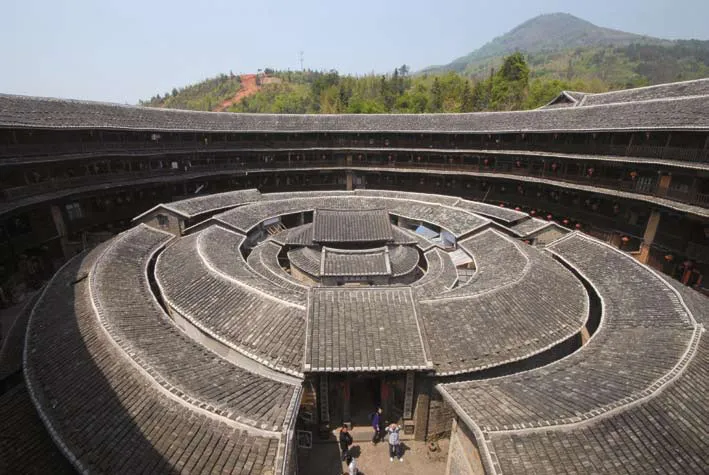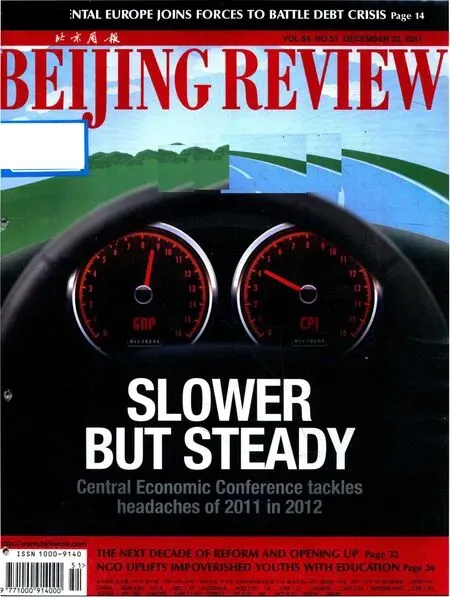Full Circle
By LU CAIRONG
Full Circle
By LU CAIRONG

The circle dwellings of Fujian Province have been recognized by UNESCO, but struggle to find a place in modern life
In the southwest of Fujian Province, there are tens of thousands of circled dwellings in remote mountains. These residential houses are enclosed by thick earth walls made with clay, bamboo and wood, in the shaped of circles, squares, pentagons orbagua, the eight diagrams used in Taoist cosmology. For this reason, these settlements are called FujianTulou.
The residents ofTulou, the Hakka people, are the descendants of Han people who came from the central plains of north China in ancient times. The ancestors of the Hakka fed for southeast China in fve large-scale migrations beginning in the Western Jin Dynasty (265-316) to avoid wars and famines. They retain many ancient customs and habits. The footprint of the Hakka people spread all over the world. Nowadays, there are over 100 million Hakka people living abroad.
For its unique design, marvelous creativity and charm of Chinese culture, the FujianTulouwas inscribed on the World Heritage List of United Nations Educational, Scientifc and Cultural Organization (UNESCO) in 2008.
Local people prefer another version of howTuloubecame well known. One day,
a U.S. satellite suddenly discovered several buildings which looked like nuclear missile silos in the mountains of Fujian Province. American military officers at the U.S. Embassy in Beijing were reportedly immediately dispatched to Yongding County in Fujian, where they discovered that the “silos”were nothing more thanTulou. As a result, FujianTulouwas unveiled to the world.
Last year, Yongding attracted over 1.8 million tourists. The average annual income of local farmers also doubled to 10,000 yuan ($1,577) from four years ago.
Two features
The bestTuloucluster is in Zhangzhou, which is about three hours’ drive away from Xiamen.
Standing on a scenic tower near terraced felds at the foot of green mountains, tourists can look at the cluster clearly, in which circle buildings encompass one square building at the center. With fresh green leaves and red persimmon fruits in autumn, theTuloulooks very beautiful.
Two other representativeTuloudwellings are located not far away. One is Chengqi Lou; the other is Zhencheng Lou. They are both typical roundTulouwith 16-meter high earth walls and four foors.
Chengqi Lou includes four circled houses with 400 rooms. A memorial temple is located at the center. The wholeTuloucan accommodate over 80 families, or about 600 people. Every family in Chengqi Lou lives in a four-storey unit. The first floor is used for the living room and dinning hall, the second foor is the granary, the third and fourth foors are bedrooms.
Built on an open square in a valley, Zhencheng Lou is surrounded by green hills with a pond in front of the gate. The beautiful scene impresses every tourist arriving here. The building complex was constructed in line with the eight diagrams pattern, dividing theTulouinto eight equal parts for two layers with 184 rooms. The inner core is a meeting hall with a stage to hold operas. Zhencheng Lou has unique features. For example, the foor was paved not by wood but by black bricks, so there is no noise when people walk on it.
In addition, each unit of the eight diagrams is separated by a brick wall and wooden door. When the doors are closed, each family has its own yard and space. When the doors are open, every unit can be connected as a whole. Because of this unique layout, families constitute a harmonious community in Zhencheng Lou.
Most residents in Chengqi Lou are surnamed Jiang, while Zhencheng Lou is inhabited by Lin families. The two big families have cultivated a lot of outstanding people including scientists, officials, scholars and merchants.
Lin Rigeng, in his 60s, is a resident of Zhencheng Lou. He is the youngest of his seven siblings. His brothers and sisters moved out to other places in China and overseas. He is left to keep the ancestors’ house and makes a living from farming. Nowadays, he has become a promoter and tour guide of localTulou, telling stories about formal residents inTulou, and explaining the architectural style and cultural characteristics to tourists.
It used to be a rule in Zhencheng Lou that the placenta of every new-born be buried under the threshold to remind grown-up children that theTuloupreserves their roots wherever they go, said Lin.
The Hakka people moved into the mountain areas to avoid wars, so they paid much attention to the defensive function of settlements. To protect themselves from beasts, bandits and roving armies, they constructed thick and high walls with a mixture of fine sand, lime and soil. The sturdy structures ofTulouare able to resist natural disasters such as storms and earthquakes.
Culture is embodied in many pairs of poem scrolls in theTulou, playing an important role in passing traditions on. For instance, a pair of scrolls in Zhencheng Lou reads: “Serve the country, read classic books,” representing the spirit of the Hakka people very well.
Modern lifestyle
ButTulouhas to survive the rapid progress of modernization and urbanization.
The old lifestyle in theTulouhas no longer attracted young generations who pursue independence and demand relative privacy. Most local people have moved to newly-built apartment buildings, making the modern lifestyle the mainstream among local people.
In addition, the construction technology and craft ofTulou, complicated, costly and time consuming, is hard to continue. People built walls with bricks made with a mixture of clay and sand, and then solidify the wall with wood and bamboo. Tourists cannot see the chimney inTuloubecause the chimney was hidden in the wall during construction. Exquisite decorations and designs can be seen everywhere in aTulou. Eastern and Western designs are so perfectly combined inTuloudwellings.
Innovation is the key
It’s a major task for residents and the local government to work on solutions to ensure the sustainable development ofTulou.
The local government is working into three directions to protect and promote theTulouand its culture, said Mao Gaoliang, head of Yongding County.
First, boosting theTulou-themed tourism and transforming local development patterns; second, producing shows and programs centered on theTulouculture, for instance, theTulouCharm concert was staged in the National Center for the Performing Arts in Beijing; third, promoting theTulouculture to the world and holding exhibitions and events overseas. The county participated in a Hakka cultural event across the Taiwan Straits, which further solidifed the compatriot bond between the mainland and Taiwan Island.
Tulouwas an innovation of the Hakka people when they moved to an unfamiliar place to avoid wars. As a unique genre of architecture,Tulouis also of important cultural values. Similarly, innovation is the only way forTulouto survive in the future.
Being one of UNESCO’s world heritage sites,Tuloudwellings are attracting a growing number of tourists from all over the world. But the shortage of tourist brochures in foreign languages has created inconvenience for overseas tourists.
In addition,Tulouclusters are located in a couple of counties and towns. Coordination and cooperation are demanded among them to promoteTulouand develop tourism. For instance, there are few roadside signs in these mountain areas that direct tourists to theirTuloudestinations.
However, local people have realized problems with insufficient facilities and services. They are looking for better ways to preserve and promoteTuloufor future generations.

XINHUA

